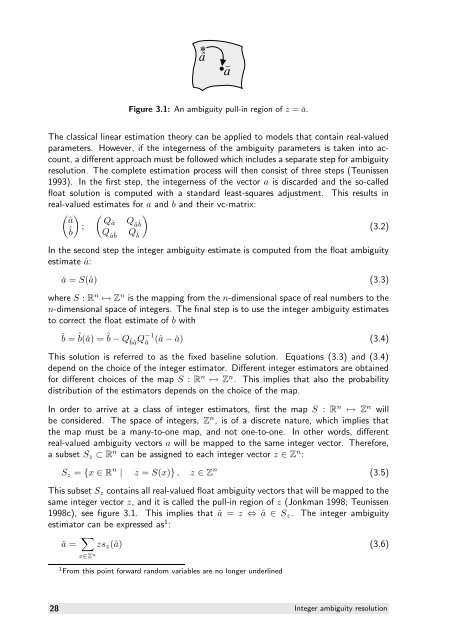The GNSS integer ambiguities: estimation and validation
The GNSS integer ambiguities: estimation and validation
The GNSS integer ambiguities: estimation and validation
You also want an ePaper? Increase the reach of your titles
YUMPU automatically turns print PDFs into web optimized ePapers that Google loves.
*<br />
â<br />
Figure 3.1: An ambiguity pull-in region of z = ǎ.<br />
<strong>The</strong> classical linear <strong>estimation</strong> theory can be applied to models that contain real-valued<br />
parameters. However, if the <strong>integer</strong>ness of the ambiguity parameters is taken into account,<br />
a different approach must be followed which includes a separate step for ambiguity<br />
resolution. <strong>The</strong> complete <strong>estimation</strong> process will then consist of three steps (Teunissen<br />
1993). In the first step, the <strong>integer</strong>ness of the vector a is discarded <strong>and</strong> the so-called<br />
float solution is computed with a st<strong>and</strong>ard least-squares adjustment. This results in<br />
real-valued estimates for a <strong>and</strong> b <strong>and</strong> their vc-matrix:<br />
<br />
â Qâ Q<br />
ˆ ;<br />
âˆb (3.2)<br />
b<br />
Q â ˆ b<br />
Qˆ b<br />
In the second step the <strong>integer</strong> ambiguity estimate is computed from the float ambiguity<br />
estimate â:<br />
a <br />
ǎ = S(â) (3.3)<br />
where S : Rn ↦→ Zn is the mapping from the n-dimensional space of real numbers to the<br />
n-dimensional space of <strong>integer</strong>s. <strong>The</strong> final step is to use the <strong>integer</strong> ambiguity estimates<br />
to correct the float estimate of b with<br />
ˇb = ˆb(ǎ) = ˆb − Qˆbâ Q −1<br />
â (â − ǎ) (3.4)<br />
This solution is referred to as the fixed baseline solution. Equations (3.3) <strong>and</strong> (3.4)<br />
depend on the choice of the <strong>integer</strong> estimator. Different <strong>integer</strong> estimators are obtained<br />
for different choices of the map S : R n ↦→ Z n . This implies that also the probability<br />
distribution of the estimators depends on the choice of the map.<br />
In order to arrive at a class of <strong>integer</strong> estimators, first the map S : R n ↦→ Z n will<br />
be considered. <strong>The</strong> space of <strong>integer</strong>s, Z n , is of a discrete nature, which implies that<br />
the map must be a many-to-one map, <strong>and</strong> not one-to-one. In other words, different<br />
real-valued ambiguity vectors a will be mapped to the same <strong>integer</strong> vector. <strong>The</strong>refore,<br />
a subset Sz ⊂ R n can be assigned to each <strong>integer</strong> vector z ∈ Z n :<br />
Sz = {x ∈ R n | z = S(x)} , z ∈ Z n<br />
(3.5)<br />
This subset Sz contains all real-valued float ambiguity vectors that will be mapped to the<br />
same <strong>integer</strong> vector z, <strong>and</strong> it is called the pull-in region of z (Jonkman 1998; Teunissen<br />
1998c), see figure 3.1. This implies that ǎ = z ⇔ â ∈ Sz. <strong>The</strong> <strong>integer</strong> ambiguity<br />
estimator can be expressed as1 :<br />
ǎ = <br />
zsz(â) (3.6)<br />
z∈Z n<br />
1 From this point forward r<strong>and</strong>om variables are no longer underlined<br />
28 Integer ambiguity resolution
















